9 Ways to Boost Your Email Open Rates

We’ve all got crowded inboxes — the average professional receives 120+ emails every day. Still, email far and away remains the most preferred method of brand communication for consumers across generations and industries. For this reason, your email open rate is a critical piece of your overall marketing ROI.
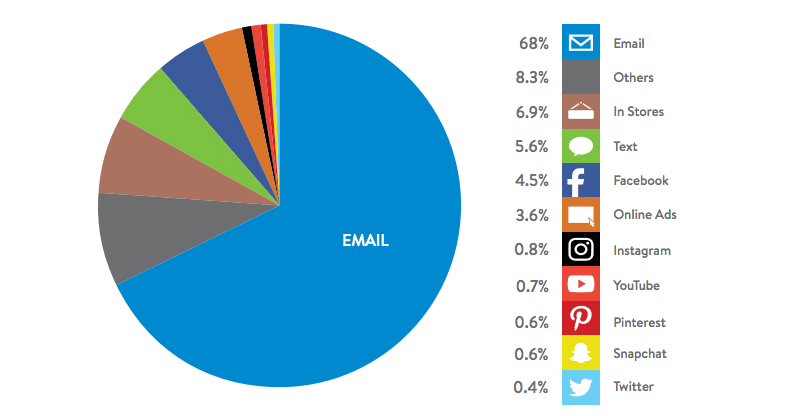
Image Source: Bluecore
When you’re executing an email marketing campaign (or managing email every day for your company) it can be easy to get laser-focused on content. After all, that’s what matters most, right?
Absolutely.
But your email content can’t perform if no one’s reading it. And no one’s reading it without first opening the emails you send.
So how do you make sure your email recipients are opening your messages to read the great content inside? That’s what we’ll cover in this article. In the sections that follow, we will:
- Go over the basics about email open rates
- Explain how to find and/or calculate your open rates
- Walk through X actionable ways to increase open rates
Let’s get started!
Quick Takeaways
- Email open rate is calculated using the number of successfully delivered emails.
- Average email open rate is about 20% across industries.
- More than one-third of people decide whether or not to open an email based on the subject line alone.
- It’s critical to follow CAN-SPAM guidelines to avoid the spam filter.
- You can use tactics like segmentation, personalization, and A/B testing to refine your strategies for better email open rates.
What is an email open rate and why is it important?
Your email open rate is the percentage of delivered emails being opened by your recipients. Delivered is a key word here — emails that bounce or are undeliverable for another reason will not be included in open rate calculations.
Open rate is one of the most commonly used metrics by email marketers to evaluate the success of their campaigns. Open rates are important because they indicate whether or not your brand name and subject lines are catching your audience’s attention in their inboxes.
How to calculate your email open rate
Calculating your email open rate is fairly straightforward. Take your total emails opened and divide it by the number of emails sent minus those that bounced.
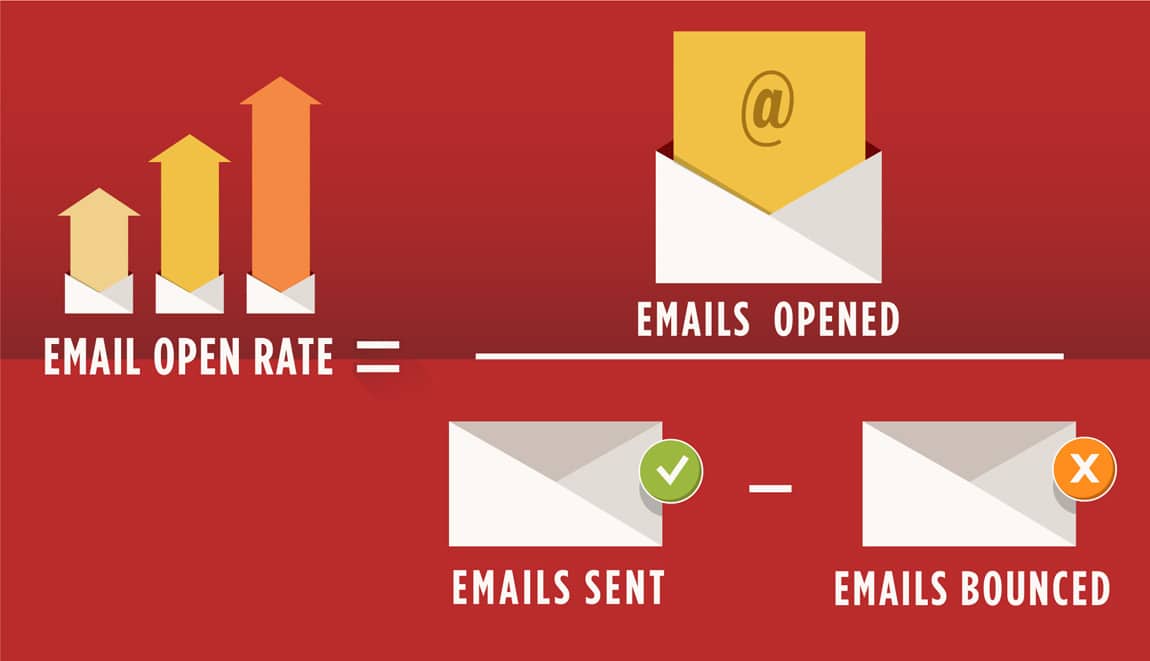
Image Source: Mailbakery
Say, for example, you sent 500 emails, 250 were opened, and 75 bounced. You would calculate: 250 / 500-75. Your email open rate would be 47%.
While average email open rates vary a bit by industry, they land right around 20% overall.
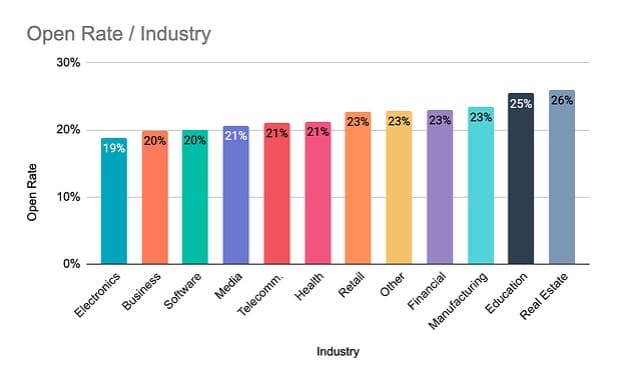
Image Source: HubSpot
Most email marketing platforms have built-in tools and reports you can access to see open rates by campaign or other factor (for example, customer segment or email list). You can also look for open rates by email when you want quick insight into how your most recent send is doing.
9 ways to boost your email open rates
Create killer subject lines
Your subject line is perhaps the most important factor of all in whether or not someone opens your emails. More than one-third of email recipients decide whether or not to open an email based on the subject line alone!
So how do you write subject lines that never fail? Here are a few quick, easy tips:
- Personalize subject lines (more on that later)
- Put value in your subject lines. Tell recipients how they’ll benefit from opening your email!
- Be concise. The best-performing subject lines stick to between 6 and 10 words
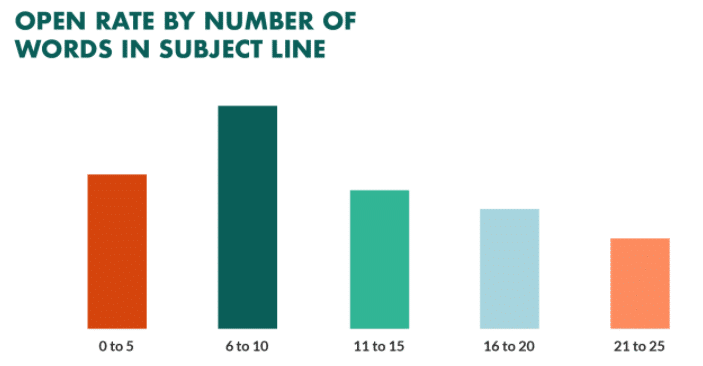
Image Source: SuperOffice
Find the right frequency and cadence
How often should you send emails? What’s the right cadence to follow? These are two important questions. There is no single right answer, but there are best practices you can follow to figure out what works best for your audience.
The key is really to test the response of your email audience and adjust until you find the sweet spot.
Here are three tips that can help:
- Be up front and honest about how often you’ll be sending emails. When people know what to expect, they’re less likely to be surprised (or worse, annoyed) by your emails.
- Segment your lists by engagement level. Your most engaged audiences might be happy to receive daily emails (and open them at a high rate). Other audiences may be happier to receive a weekly or monthly message.
- Ask your audience! You can include a simple survey that asks: “How often would you like to receive our emails?” Adjust your strategy based on responses.
Avoid the spam filter
Ah, the dreaded black hole of the spam filter! While it’s a good idea to check your spam filter periodically for emails you may be missing, many people never do it at all.
Most of the time, when your emails are hitting the spam folder it’s for a clear and fixable reason. First and foremost, make sure you’re following CAN-SPAM guidelines. CAN-SPAM is an act that was passed in the early 2000s to prevent people from receiving SPAM.
The image below summarizes CAN-SPAM well.
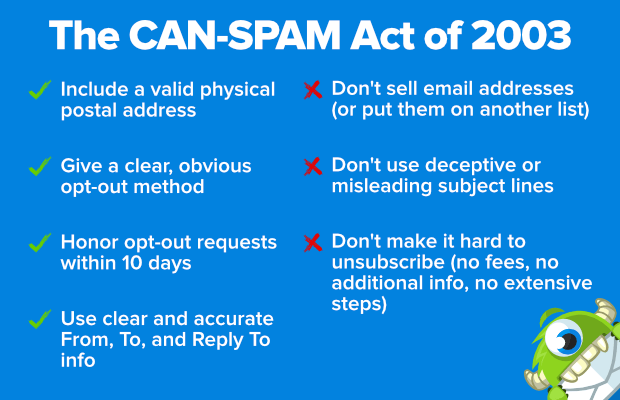
Image Source: OptinMonster
Clean up your email lists
Take time to clean up your email lists regularly. Believe it or not, email lists decay at a rate of up to 30% every year. Emails that were good for one campaign may become outdated before your next one. When you have bad emails on your list, your bounce rate goes up and your email open rate decreases.
Segment your lists
Beyond managing your lists to keep them accurate, email segmentation for a more targeted email strategy can be a really effective way to boost open rates. People are more likely to open emails that are hyper-relevant to their interests and needs. When you segment your lists, you can deliver uniquely targeted messages that stand out to recipients.
The best way to segment your lists is to ask people what they want to know about when they subscribe to your email list. When you do, you can filter email addresses automatically onto the lists that make the most sense for each subscriber.
Personalize emails
While most email recipients today can recognize automated personalization, it can still go a long way in catching their attention and getting people to think twice about opening an email. It can be as simple as a first name (i.e. “Michael, we think you’d really enjoy these email marketing tips.”).
Personalization can go beyond first names, too. You can personalize in some other ways, such as:
- Mentioning places and events local to recipients
- Recommending new content based on past engagement
- Offering deals based on past purchases and preferences
Utilize the A/B testing feature
A/B testing (or split testing) in email marketing is the process of experimenting with different versions of the same email to determine what earns the best results. Most email marketing platforms offer easy A/B testing features that allow you to do it automatically.
Below you can see that subject lines and CTAs are the most commonly A/B tested items, but other factors like send time, content blocks, images, and layout are also worth testing.
 Image Source: litmus
Image Source: litmus
Ask for (and use) feedback
There’s no better source of information about how your emails are resonating than your audience themselves. Whether you feel like your email open rates are right where they should be or you know they need to improve, asking your audience for feedback can give you great starting points for refining and optimizing your strategy.
There are a few ways to go about it. You can send a dedicated email with a survey that asks for feedback. Another approach is to include a quick question or two at the end of every message (it could be as simple as: “Did you enjoy this email?”).
When you’re armed with direct feedback, you can identify specific things that are working (like certain topics or subject line styles).
Create awesome content
There’s no doubt about it: great content is the best way to create a truly engaged audience over time — an audience that opens your emails!
Email is a great channel for sharing your blog content and other important content you want your audiences to see (and a great opportunity to nurture leads). When you consistently create customer-focused content that delivers real value and helps your audience solve their problems, you can be confident people will pay more attention to your emails when they arrive in their inboxes.
Boost your email open rates with compelling content
Email marketing and content creation are two of the most time consuming priorities for digital marketers today — but they’re also the most important. The team of writers and SEO experts at Marketing Insider Group can deliver you optimized, ready-to-publish content every week for a year (or more) so that you can focus on connecting directly with your audience.
Check out our SEO Blog Writing Service or schedule a quick consultation with me to learn more!
The post 9 Ways to Boost Your Email Open Rates appeared first on Marketing Insider Group.




